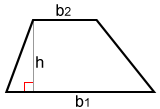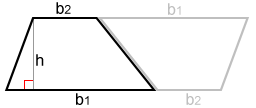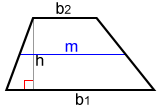Area of a trapezoid
The area of a trapezoid is the space contained within its perimeter. The grey space is the area of the trapezoid in the diagram below.

Area formula of a trapezoid
The area, A, of a trapezoid is:
where h is the height and b1 and b2 are the base lengths.

Derivation
Given a trapezoid, if we form a congruent trapezoid and rotate it such that the two congruent trapezoids can be joined together to form a parallelogram as shown by the congruent black and grey trapezoids below.

The area of a parallelogram is A = bh. The parallelogram formed by the two congruent trapezoids has a base b1 + b2 and height h. Therefore, the area of this parallelogram is: A = (b1 + b2)h. Since the parallelogram is made up of two congruent trapezoids, halving the above formula gives us the formula for the area of one of the trapezoids:
Example:
Find the area of a trapezoid that has height of 16 and bases of 18 and 35.
Plugging these into the area formula:
Using the midsegment
The midsegment of a trapezoid is a line segment connecting the midpoint of its legs. A midsegment has a length that is the average of its two bases, which is
The area, A, of a trapezoid using the length of the midsegment is:
A = hm

Derivation
Substituting the value for m into the original trapezoid area formula:
Finding area using a grid
Another way to find the area of a trapezoid is to determine how many unit squares it takes to cover its surface. Below is a unit square with side lengths of 1 cm.

A grid of unit squares can be used when determining the area of a trapezoid.

The grid above contains unit squares that have an area of 1 cm2 each. The trapezoid on the left contains 6 full squares and 4 partial squares, so it has an area of approximately:
The trapezoid to the right contains 7 full squares and 4 partial squares, so it has an area of approximately:
This method can be used to find the area of any shape; it is not limited to trapezoids. However, it is only an approximate value of the area. The smaller the unit square used, the higher the accuracy of the approximation. Using a grid made up of 1 mm squares is 10 times more accurate than using a grid made up of 1 cm squares.
